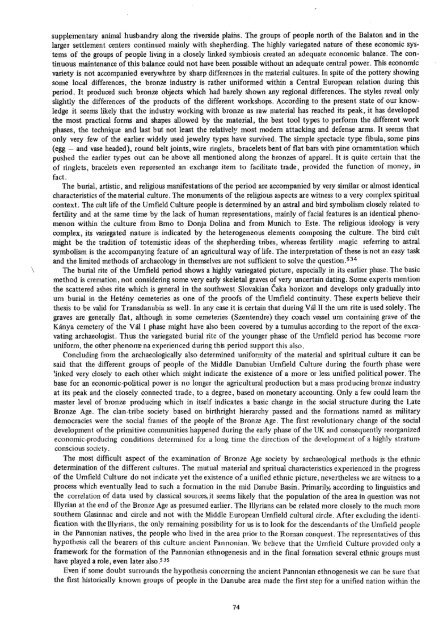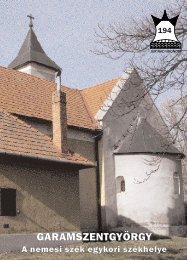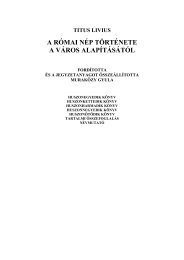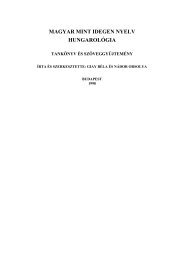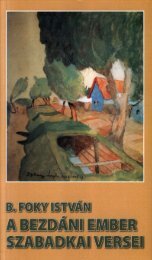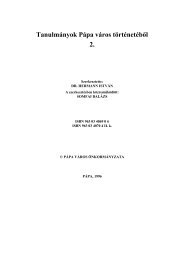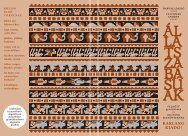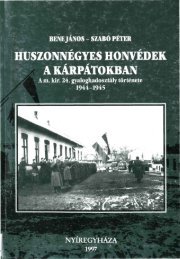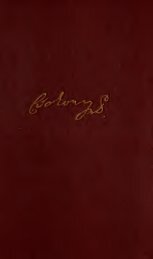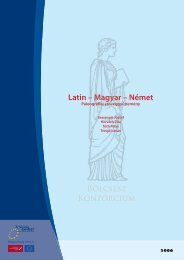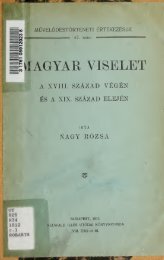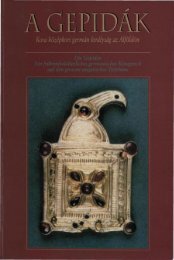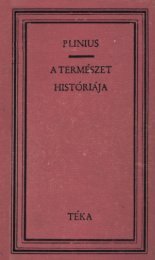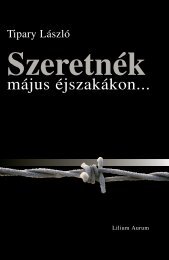A Dunántúl Története A KésÅbronzkorban (BTM műhely 1. kötet ...
A Dunántúl Története A KésÅbronzkorban (BTM műhely 1. kötet ...
A Dunántúl Története A KésÅbronzkorban (BTM műhely 1. kötet ...
Create successful ePaper yourself
Turn your PDF publications into a flip-book with our unique Google optimized e-Paper software.
supplementary animal husbandry along the riverside plains. The groups of people north of the Balaton and in the<br />
larger settlement centers continued mainly with shepherding. The highly variegated nature of these economic systems<br />
of the groups of people living in a closely linked symbiosis created an adequate economic balance. The continuous<br />
maintenance of this balance could not have been possible without an adequate central power. This economic<br />
variety is not accompanied everywhere by sharp differences in the material cultures. In spite of the pottery showing<br />
some local differences, the bronze industry is rather uniformed within a Central European relation during this<br />
period. It produced such bronze objects which had barely shown any regional differences. The styles reveal only<br />
slightly the differences of the products of the different workshops. According to the present state of our knowledge<br />
it seems likely that the industry working with bronze as raw material has reached its peak, it has developed<br />
the most practical forms and shapes allowed by the material, the best tool types to perform the different work<br />
phases, the technique and last but not least the relatively most modem attacking and defense arms. It seems that<br />
only very few of the earlier widely used jewelry types have survived. The simple spectacle type fibula, some pins<br />
(egg - and vase headed), round belt joints, wire ringlets, bracelets bent of flat bars with pine ornamentation which<br />
pushed the earlier types out can be above all mentioned along the bronzes of apparel. It is quite certain that the<br />
of ringlets, bracelets even represented an exchange item to facilitate trade, provided the function of money, in<br />
fact.<br />
The burial, artistic, and religious manifestations of the period are accompanied by very similar or almost identical<br />
characteristics of the material culture. The monuments of the religious aspects are witness to a very complex spiritual<br />
context. The cult life of the Urnfield Culture people is determined by an astral and bird symbolism closely related to<br />
fertility and at the same time by the lack of human representations, mainly of facial features is an identical phenomenon<br />
within the culture from Brno to Donja Dolina and from Munich to Este. The religious ideology is very<br />
complex, its variegated nature is indicated by the heterogeneous elements composing the culture. The bird cult<br />
might be the tradition of totemistic ideas of the shepherding tribes, whereas fertility magic referring to astral<br />
symbolism is the accompanying feature of an agricultural way of life. The interpretation of these is not an easy task<br />
and the limited methods of archaeology in themselves are not sufficient to solve the question. 534<br />
The burial rite of the Urnfield period shows a highly variegated picture, especially in its earlier phase. The basic<br />
method is cremation, not considering some very early skeletal graves of very uncertain dating. Some experts mention<br />
the scattered ashes rite which is general in the southwest Slovakian Őaka horizon and develops only gradually into<br />
urn burial in the Hetény cemeteries as one of the proofs of the Urnfield continuity. These experts believe their<br />
thesis to be valid for Transdanubia as well. In any case it is certain that during Vál II the urn rite is used solely. The<br />
graves are generally flat, although in some cemeteries (Szentendre) they coach vessel urn containing grave of the<br />
Kánya cemetery of the Vál I phase might have also been covered by a tumulus according to the report of the excavating<br />
archaeologist. Thus the variegated burial rite of the younger phase of the Urnfield period has become more<br />
uniform, the other phenomena experienced during this period support this also.<br />
Concluding from the archaeologically also determined uniformity of the material and spiritual culture it can be<br />
said that the different groups of people of the Middle Danubian Urnfield Culture during the fourth phase were<br />
Ünked very closely to each other which might indicate the existence of a more or less unified political power. The<br />
base for an economic-political power is no longer the agricultural production but a mass producing bronze industry<br />
at its peak and the closely connected trade, to a degree, based on monetary accounting. Only a few could leam the<br />
master level of bronze producing which in itself indicates a basic change in the social structure during the Late<br />
Bronze Age. The clan-tribe society based on birthright hierarchy passed and the formations named as military<br />
democracies were the social frames of the people of the Bronze Age. The first revolutionary change of the social<br />
development of the primitive communities happened during the early phase of the UK and consequently reorganized<br />
economic-producing conditions determined for a long time the direction of the development of a highly stratum<br />
conscious society.<br />
The most difficult aspect of the examination of Bronze Age society by archaeological methods is the ethnic<br />
determination of the different cultures. The mutual material and spritual characteristics experienced in the progress<br />
of the Urnfield Culture do not indicate yet the existence of a unified ethnic picture, nevertheless we are witness to a<br />
process which eventually lead to such a formation in the mid Danube Basin. Primarily, according to linguistics and<br />
the correlation of data used by classical sources, it seems likely that the population of the area in question was not<br />
Illyrian at the end of the Bronze Age as presumed earlier. The Illyrians can be related more closely to the much more<br />
southern Glasinnac and circle and not with the Middle European Urnfield cultural circle. After excluding the identification<br />
with the Illyrians, the only remaining possibility for us is to look for the descendants of the Urnfield people<br />
in the Pannonian natives, the people who lived in the area prior to the Roman conquest. The representatives of this<br />
hypothesis call the bearers of this culture ancient Pannonian. We believe that the Urnfield Culture provided only a<br />
framework for the formation of the Pannonian ethnogenesis and in the final formation several ethnic groups must<br />
have played a role, even later also. 535<br />
Even if some doubt surrounds the hypothesis concerning the ancient Pannonian ethnogenesis we can be sure that<br />
the first historically known groups of people in the Danube area made the first step for a unified nation within the


